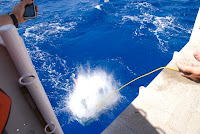By Steve Lindfield
University of Western Australia/ University of Guam
Background:
Baited Remote Underwater Video Stations (BRUVS) are a method for sampling fish communities across a broad range of depths and habitats. There have been many different forms of baited stations used by researchers over the world. However the present form that I will be using on this NOAA cruise are stereo-BRUVS that have been designed by Dr Euan Harvey from the University of Western Australia. I have previously spent many years using single camera BRUVS assessing fish populations on the east coast of Australia. But this is the first time I have foraged into the use of stereo-systems and this research will form part of my PhD thesis studying deeper water coral reef fish communities and the effects of fishing pressure.
Use of BRUVS:
BRUVS are a cost efficient method for studying fish communities. With each system costing approximately $5000, it is normal practice to use multiple units at the same time. For this cruise I will be using 8 systems. As these systems are remote and sit on the seafloor like a fish trap, only a rope to the surface is needed to retrieve them. So we can just literally throw them off the back of the boat at pre-defined GPS positions then come around and pick them all up. On this trip it has allowed us to gather 8 hrs of video footage over a period of 3 hrs! Having multiple systems deployed at once (which are spaced at least 250m apart) provides a good spatial coverage of the area and having replication within an area improves the statistical power of the fish assessment.
These systems are left to film on the sea floor for no less than 60 minutes. Each stereo BRUV is baited with 1 kg of oily fish (in this case, pacific saury) which is placed in a closed plastic-coated wire basket and suspended 1.2 m in front of the two cameras. This is used to attract the fish into the field of view. The bait not only attracts fish that are carnivorous such as sharks and snapper (which are the ones most affected by fishing pressure), but also many smaller reef fish that like to feed on invertebrates, plankton, coral and algae. I am estimating over 400 fish species will be sampled around the Mariana Archipelago using BRUVS.
Stereo-vision:
The use of stereo-video has become the most accurate way to size fish (without capturing them). When assessing fish populations it is very important to know accurate sizes of fish, this is especially important when looking at the effects of fishing pressure. Fishing normally targets the large fish – but these large mature fish are most important for the future of the fish stock as they are the breeders and produce far greater numbers of offspring than smaller fish, even if the smaller fish are reproductively active.
To achieve stereo vision, these systems comprise of two high-definition SONY handy-cams mounted 0.7 m apart on a base bar, which is inwardly converged at 8 degrees to gain an optimized field of view with visibility of 10 m distance. This does not allow the viewer to see in 3D (I wish it did!) but allows specially designed computer software to calculate distance after calibrating the cameras. Distance can be measured in 3 dimensions so not only can we know how long a fish is but we can also know how far away it is from the camera. The distance away from the camera allows us to standardise the area that we are sampling, this is very important when counting numbers of fish.
Video footage can be reviewed as soon as the camera is retrieved to the vessel. Video footage is stored on flash memory cards and these cards are stored and later downloaded and backed up on hard drives in the evenings. There has been specialised software developed for analysing BRUVS footage and we typically analyse the number of species and their relative abundance. Called MaxN, the relative abundance is the “maximum number of each fish species seen at any one time during the 60 minutes of footage”. So after the cruise I will have lots of footage to analyse! So far in the 2 weeks I was working on the cruise I was able to get 122 stereo BRUVS deployments, at 3 hrs worth of analysis per drop, this will be 366 hrs of work (or 9.5 weeks!)
Left: Tossing the BRUV off the ship.
Below: Using the small boat to place the BRUVs











